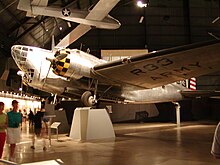Douglas B-18
| Douglas B-18 Bolo | |
|---|---|
 USAAC's B-18 “Bolo” |
|
| Type: | bomber |
| Design country: | |
| Manufacturer: | |
| First flight: |
April 1936 |
| Commissioning: |
1937 |
| Production time: |
1937 to 1939 |
| Number of pieces: |
351 |
The Douglas B-18 Bolo was a twin-engine bomber of the 1930s from American production. The low-wing aircraft was based on the Douglas DC-2 and was used with the United States Army Air Corps and the Royal Canadian Air Force until the early 1940s .
history
In 1934, the United States Army Air Corps made a request for a twin-engine bomber that would have twice the bomb load and twice the range of the Martin B-10 . In 1935 a comparison test followed in Wright Field . Here Douglas showed his DB-1 . It was in competition with the Boeing Model 299 , the later B-17 Flying Fortress and the Martin Model 146 . Boeing had the better design, but the B-17 prototype crashed and was therefore eliminated for the time being. The DB-1 was cheaper at $ 58,500 versus the B-17's $ 99,620 . In particular, since state funds were limited during the Great Depression , immediate production of the B-18 was initiated in January 1936.
The DB-1 was largely derived from the Douglas DC-2 , but with several modifications. The wingspan was 1.4 m larger and the fuselage was deeper to provide more space for bombs and the six-person crew. In the floor pan there was also space for a gunner. The bomber was equipped with two Wright R- 1820-45 Cyclone 9 radial engines, each with 930 hp (694 kW).
In the first contract, 133 B-18s (including DB-1s) with Wright radial engines were ordered. The last machine in this series was called the DB-2 and had a motorized gun turret in the aircraft nose. Further contracts followed in 1937 with 177 machines and in 1938 with 40 machines of the type B-18A . The B-18A had another bombardier position in the aircraft's nose and more powerful Wright R- 1820-53 radial engines with 1,000 hp (746 kW) .
From 1940, most of the bomber units were equipped with B-18 and B-18A. Some of these bombers were destroyed in the attack on Pearl Harbor on December 7, 1941 .

Starting in 1942, the B-18 was displaced from the first line of battle by B-17 bombers. 122 B-18A were converted into submarine fighters. The bomb bays were equipped with a magnetic anomaly search device . These aircraft were designated B-18B and were hunting submarines in the Caribbean . Two machines were delivered to the Brazilian Air Force in 1942 . The Royal Canadian Air Force procured a 20 B-18A, as Douglas Digby Mark I were called. In total, the Bolos and Digbys were able to sink four submarines.
Museum aircraft
- B-18 s / n 37-0029 in the Castle Air Museum , Atwater .
- B-18A s / n 37-469 in the National Museum of the United States Air Force , Wright-Patterson AFB, Ohio .
- B-18A s / n 39-25 at the Wings Over the Rockies Air and Space Museum , Denver .
- B-18B s / n 37-505 at the McChord Air Museum, McChord Air Force Base , Washington.
- B-18B s / n 38-593 at the Pima Air & Space Museum , Tucson .
variants
- DB-1
- Prototype, 1 built
- DB-2
- Version with motorized turret in the aircraft nose; one built (last B-18)
- B-18
- Production version, 133 built
- B-18A
- B-18 with Wright R- 1820-53 engine, bombardier position relocated to nose, 217 built
- B-18B
- 122 B-18A converted to combat submarines
- B-18C
- 2 B-18A converted to combat submarines
- B-18M
- B-18 converted into training aircraft
- B-18AM
- B-18A converted into training aircraft
- XB-22
- Project of a B-18 with Wright R-2600 3 radial engines (1,600 HP, 1194 kW), not built
- C-58
- B-18 / B-18A converted to transport aircraft
- Digby Mk I.
- 20 B-18A converted for anti-submarine combat that were taken over by the Royal Canadian Air Force
Military use
Technical specifications
| Parameter | Data of the B-18A |
|---|---|
| crew | 6th |
| length | 17.6 m |
| span | 27.3 m |
| Wing area | 89.1 m² |
| height | 4.6 m |
| Empty mass | 7,400 kg |
| Takeoff mass | 10,030 kg |
| drive | 2 × 9-cylinder radial engines Wright R-1820 -53 with 1,000 HP each (approx. 740 kW) |
| Top speed | 346 km / h |
| Service ceiling | 7280 m |
| Range | 1850 km |
| Armament | three 7.7 mm machine guns, 2200 kg bombs |
literature
- René J. Francillon: McDonnell Douglas Aircraft Since 1920. Volume I. Putnam, London 1979, ISBN 0-87021-428-4 .
Web links
- USAF Museum, description of the B-18 (English)
- AeroWeb.com B-18 listing (English)
- Side to Digby Mk I (English)

